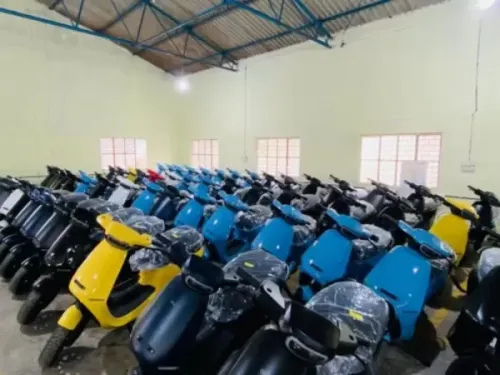Ola Electric’s New Milestone
Ola Electric, a pioneer in India’s electric vehicle (EV) market, has made a significant announcement that is set to reshape the landscape of electric mobility in the country. The company has introduced a new range of electric motorcycles, marking a bold step forward in its mission to accelerate the transition to sustainable transportation. Alongside this, Ola Electric has unveiled plans to integrate its own battery cells into its EVs by the first quarter of FY26, a move that underscores its commitment to innovation and self-reliance in the rapidly evolving EV industry.
Table of Contents
Expanding the Product Line
The launch of e-motorcycles by Ola Electric is a strategic move that aims to broaden its product portfolio and cater to a wider range of customers. These motorcycles, designed with the needs of urban commuters in mind, offer a combination of performance, efficiency, and sustainability. By venturing into the two-wheeler segment, Ola Electric is not only diversifying its offerings but also positioning itself as a leader in the electric mobility space. This expansion is expected to capture a significant share of the market, which is witnessing a growing demand for eco-friendly transportation solutions.
Innovation at the Core
Innovation has always been a driving force behind Ola Electric’s success. The company’s decision to develop and integrate its own battery cells is a testament to its focus on cutting-edge technology and long-term sustainability. Battery cells are a crucial component of any electric vehicle, and by producing them in-house, Ola Electric is taking control of one of the most critical aspects of EV manufacturing. This move is expected to enhance the efficiency, reliability, and performance of its electric vehicles, while also reducing dependency on external suppliers. By Q1 FY26, Ola Electric plans to have these self-manufactured cells powering its range of EVs, making the company more self-reliant and competitive in the global market.
Strengthening India’s EV Ecosystem
Ola Electric’s initiative to produce battery cells locally aligns with India’s broader vision of becoming a global hub for electric vehicles. The Indian government has been actively promoting the adoption of EVs and the development of a robust domestic supply chain. Ola Electric’s move to integrate its own cells into its EVs is expected to contribute significantly to this goal. By investing in local manufacturing and research, the company is not only strengthening its own capabilities but also contributing to the growth of India’s EV ecosystem. This effort is likely to create jobs, foster innovation, and reduce the country’s reliance on imported components.
Commitment to Sustainability
Ola Electric’s commitment to sustainability goes beyond just producing electric vehicles. The company is focused on creating a holistic ecosystem that promotes sustainable practices at every level. From the design and manufacturing of its vehicles to the sourcing of raw materials and the development of charging infrastructure, Ola Electric is committed to minimizing its environmental footprint. The integration of in-house battery cells is a critical part of this strategy, as it allows the company to control the entire lifecycle of its products, ensuring that they meet the highest standards of sustainability.
Addressing the Challenges
While Ola Electric’s plans are ambitious, they are not without challenges. Developing and manufacturing battery cells is a complex and capital-intensive process that requires significant investment in research, technology, and infrastructure. Ola Electric will need to navigate technical challenges, such as ensuring the safety, efficiency, and longevity of its cells, as well as scaling up production to meet the growing demand for EVs. Additionally, the company will need to address the competitive pressures from established players in the global battery manufacturing industry. However, with its track record of innovation and execution, Ola Electric is well-positioned to overcome these challenges and achieve its goals.
Impact on the Market
The introduction of Ola Electric’s e-motorcycles and the integration of its own battery cells are expected to have a profound impact on the market. The availability of high-performance, reliable, and affordable electric motorcycles will likely drive increased adoption of EVs among consumers. This, in turn, will contribute to the reduction of carbon emissions and the improvement of air quality in urban areas. Moreover, Ola Electric’s focus on self-reliance and local manufacturing could set a new benchmark for the industry, encouraging other players to invest in domestic production and innovation. This could lead to a more competitive and vibrant EV market in India and beyond.
Vision for the Future
Ola Electric’s latest announcements reflect its vision for the future of mobility. The company is not just focused on building vehicles but on creating a comprehensive ecosystem that supports the transition to electric mobility. This includes investing in technology, infrastructure, and partnerships that can accelerate the adoption of EVs and make them accessible to a broader audience. Ola Electric envisions a future where electric vehicles are the norm, and it is actively working towards making this a reality. By leading the charge in innovation and sustainability, Ola Electric is setting the stage for a new era in transportation.
Conclusion
Ola Electric’s launch of e-motorcycles and the plan to integrate its own battery cells by Q1 FY26 represent a significant step forward in the company’s journey. These initiatives underscore Ola Electric’s commitment to innovation, sustainability, and self-reliance, and they are expected to have a far-reaching impact on the EV market in India and globally. As the company continues to push the boundaries of what is possible in electric mobility, it is well on its way to becoming a global leader in the industry. The future of transportation is electric, and Ola Electric is at the forefront of this revolution, driving change and making sustainable mobility a reality for all.








